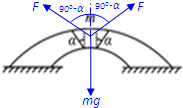如图所示,石拱桥的正中央有一质量为m的对称楔形石块,侧面与竖直方向的夹角为α,重力加速度为g.若接触面间的摩擦力忽略不计,求石块侧面所受弹力的大小为多少?


以楔形石块为研究对象,受到重力mg,两侧拱桥的弹力F,受力如图,由平衡条件根据力的合成法可得:
mg=2Fcos(90°-α),
所以F=
=mg 2cos(900-α) mg 2sinα
答:石块侧面所受弹力的大小为mg 2sinα
如图所示,石拱桥的正中央有一质量为m的对称楔形石块,侧面与竖直方向的夹角为α,重力加速度为g.若接触面间的摩擦力忽略不计,求石块侧面所受弹力的大小为多少?


以楔形石块为研究对象,受到重力mg,两侧拱桥的弹力F,受力如图,由平衡条件根据力的合成法可得:
mg=2Fcos(90°-α),
所以F=
=mg 2cos(900-α) mg 2sinα
答:石块侧面所受弹力的大小为mg 2sinα